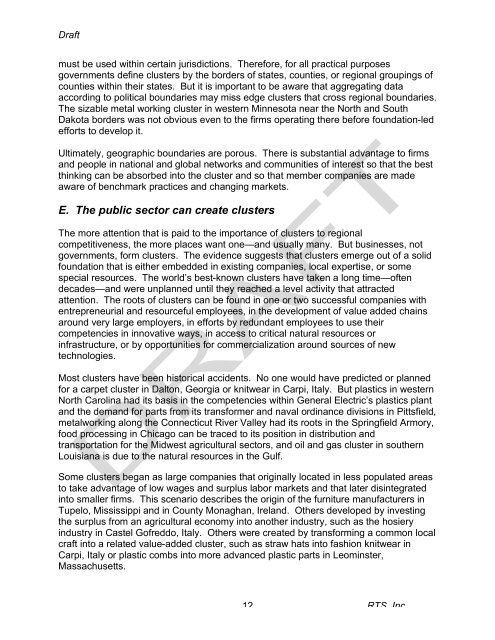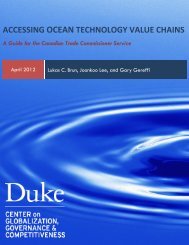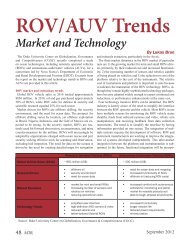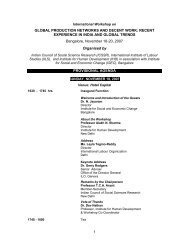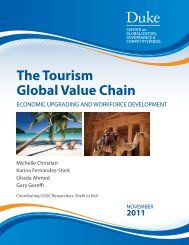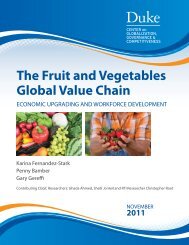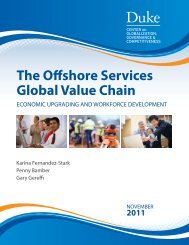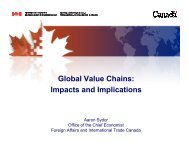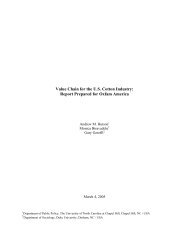Paper - Center on Globalization, Governance & Competitiveness
Paper - Center on Globalization, Governance & Competitiveness
Paper - Center on Globalization, Governance & Competitiveness
Create successful ePaper yourself
Turn your PDF publications into a flip-book with our unique Google optimized e-Paper software.
Draft<br />
must be used within certain jurisdicti<strong>on</strong>s. Therefore, for all practical purposes<br />
governments define clusters by the borders of states, counties, or regi<strong>on</strong>al groupings of<br />
counties within their states. But it is important to be aware that aggregating data<br />
according to political boundaries may miss edge clusters that cross regi<strong>on</strong>al boundaries.<br />
The sizable metal working cluster in western Minnesota near the North and South<br />
Dakota borders was not obvious even to the firms operating there before foundati<strong>on</strong>-led<br />
efforts to develop it.<br />
Ultimately, geographic boundaries are porous. There is substantial advantage to firms<br />
and people in nati<strong>on</strong>al and global networks and communities of interest so that the best<br />
thinking can be absorbed into the cluster and so that member companies are made<br />
aware of benchmark practices and changing markets.<br />
E. The public sector can create clusters<br />
The more attenti<strong>on</strong> that is paid to the importance of clusters to regi<strong>on</strong>al<br />
competitiveness, the more places want <strong>on</strong>e—and usually many. But businesses, not<br />
governments, form clusters. The evidence suggests that clusters emerge out of a solid<br />
foundati<strong>on</strong> that is either embedded in existing companies, local expertise, or some<br />
special resources. The world’s best-known clusters have taken a l<strong>on</strong>g time—often<br />
decades—and were unplanned until they reached a level activity that attracted<br />
attenti<strong>on</strong>. The roots of clusters can be found in <strong>on</strong>e or two successful companies with<br />
entrepreneurial and resourceful employees, in the development of value added chains<br />
around very large employers, in efforts by redundant employees to use their<br />
competencies in innovative ways, in access to critical natural resources or<br />
infrastructure, or by opportunities for commercializati<strong>on</strong> around sources of new<br />
technologies.<br />
Most clusters have been historical accidents. No <strong>on</strong>e would have predicted or planned<br />
for a carpet cluster in Dalt<strong>on</strong>, Georgia or knitwear in Carpi, Italy. But plastics in western<br />
North Carolina had its basis in the competencies within General Electric’s plastics plant<br />
and the demand for parts from its transformer and naval ordinance divisi<strong>on</strong>s in Pittsfield,<br />
metalworking al<strong>on</strong>g the C<strong>on</strong>necticut River Valley had its roots in the Springfield Armory,<br />
food processing in Chicago can be traced to its positi<strong>on</strong> in distributi<strong>on</strong> and<br />
transportati<strong>on</strong> for the Midwest agricultural sectors, and oil and gas cluster in southern<br />
Louisiana is due to the natural resources in the Gulf.<br />
Some clusters began as large companies that originally located in less populated areas<br />
to take advantage of low wages and surplus labor markets and that later disintegrated<br />
into smaller firms. This scenario describes the origin of the furniture manufacturers in<br />
Tupelo, Mississippi and in County M<strong>on</strong>aghan, Ireland. Others developed by investing<br />
the surplus from an agricultural ec<strong>on</strong>omy into another industry, such as the hosiery<br />
industry in Castel Gofreddo, Italy. Others were created by transforming a comm<strong>on</strong> local<br />
craft into a related value-added cluster, such as straw hats into fashi<strong>on</strong> knitwear in<br />
Carpi, Italy or plastic combs into more advanced plastic parts in Leominster,<br />
Massachusetts.<br />
12<br />
RTS, Inc.


